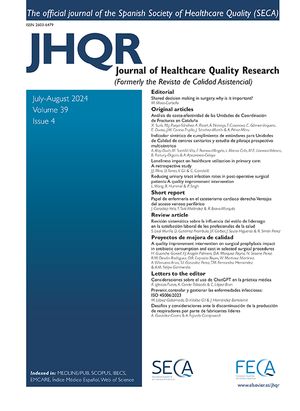Para valorar la calidad asistencial (CA) que se da a los pacientes con insuficiencia cardíaca (IC), se cuenta con herramientas que permiten medir y comparar si el nivel de nuestra asistencia alcanza la calidad recomendada por la evidencia científica de las guías clínicas, tales como indicadores, criterios y estándares de calidad.
MétodosSe pretende valorar los niveles que alcanzan los criterios de CA establecidos en las guías clínicas de IC en pacientes seguidos de forma ambulatoria en la unidad de insuficiencia cardíaca (UIC) de nuestro hospital. Para lo cual, entre junio de 2003 y diciembre de 2004, se incluyeron en la base de datos de pacientes con IC (BADAPIC) 124 pacientes para su control, tratamiento y seguimiento.
ResultadosLa edad media fue de 70,9 años (el 85% eran mayors de 60 años y el 70%, varones). La etiología de la IC fue en el 50% hipertensión arterial, en el 49%, cardiopatía isquémica (CI), en el 18,5%, miocardiopatía dilatada, en el 25%, valvulopatías significativas.Se encontraban en fibrilación auricular (FA) el 25,8% y la distribución de la clase funcional de la NYHA era I en el 1,6%, II en el 34,6%, III en el 60,4% y IV en el 2,4%. Se evaluó la fracción de eyección ventricular izquierda mediante ecocardiografía en el 100% de los pacientes y la función diastólica en el 74%. Durante el seguimiento no se produjo ninguna muerte y sólo reingresó el 2,4%. Recibieron tratamiento con bloqueadores beta el 93%, con inhibidores de la enzima de conversión de la angiotensina el 65%,antagonistas de los receptores de la angiotensina el 40%, diuréticos el 94%, espironolactona el 78% y el 100% de los pacientes con FA fueron anticoagulados.
ConclusionesAunque el volumen de paciente y el período analizado es corto, su seguimiento nos ha permitido establecer que los criterios de CA evaluados en los pacientes de nuestra UIC alcanzan niveles muy altos, y se pueden resumir en: bajo índice de reingresos; nula mortalidad, y alta utilización de los fármacos que mayor influencia tienen en el pronóstico de la IC.
Tools are available to evaluate the quality of the care provided to patients with heart failure (HF). These tools allow us to determine whether the quality of our healthcare reaches that recommended by the scientific evidence in clinical guidelines, such as indicators, criteria, and quality standards.
MethodsWe aimed to evaluate whether the quality of care received by outpatients attending the Heart Failure Unit in our hospital matched the quality criteria established in clinical guidelines for patients with HF. Between June 2003 and December 2004, 124 patients were included in the HF patient database for monitoring,treatment, and follow-up.
ResultsThe mean age was 70.9 years (85% were aged more than 60 years old and 70% were men). HF was caused by hypertension in 50%, ischemic heart disease in 49%, idiopathic dilated cardiomyopathy in 18.5%, and significant valvular disease in 25%. A total of 25.8% were in atrial fibrillation. The distribution of NYHA functional class was class I in 1.6%, class II in 34.6%, class III in 60.4%, and class IV in 2.4%. Left ventricular ejection fraction was evaluated by echocardiography in all patients and diastolic function was evaluated in 74%. No deaths occurred during follow-up and only 2.4% of the patients were readmitted. Treatment consisted of beta-blockers in 93%, angiotensin-converting enzyme inhibitors in 65%, angiotensin II receptor antagonists in 40%, diuretics in 94%,and spironolactone in 78%. All patients with atrial fibrillation were anticoagulated.
ConclusionsAlthough the volume of patients was small and the time period analyzed was short, follow-up of these patients has allowed us to establish that the quality criteria evaluated in patients attending our Heart Failure Unit achieved very high levels.This was reflected in: the low readmission rate, null mortality, and high use of drugs with the greatest influence on the prognosis of HF.






